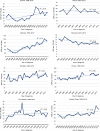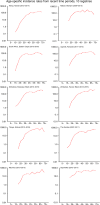Trends in cervical cancer incidence in sub-Saharan Africa
- PMID: 32336751
- PMCID: PMC7341858
- DOI: 10.1038/s41416-020-0831-9
Trends in cervical cancer incidence in sub-Saharan Africa
Abstract
Background: Cervical cancer is the second most common cancer and the leading cause of cancer death in women in sub-Saharan Africa (SSA).
Methods: Trends in the incidence of cervical cancer are examined for a period of 10-25 years in 10 population-based cancer registries across eight SSA countries (Gambia, Kenya, Malawi, Mauritius, Seychelles, South Africa, Uganda and Zimbabwe). A total of 21,990 cases of cervical cancer were included in the analyses.
Results: Incidence rates had increased in all registries for some or all of the periods studied, except for Mauritius with a constant annual 2.5% decline. Eastern Cape and Blantyre (Malawi) registries showed significant increases over time, with the most rapid being in Blantyre (7.9% annually). In Kampala (Uganda), a significant increase was noted (2.2%) until 2006, followed by a non-significant decline. In Eldoret, a decrease (1998-2002) was followed by a significant increase (9.5%) from 2002 to 2016.
Conclusion: Overall, cervical cancer incidence has been increasing in SSA. The current high-level advocacy to reduce the burden of cervical cancer in SSA needs to be translated into support for prevention (vaccination against human papillomavirus and population-wide screening), with careful monitoring of results through population-based registries.
Conflict of interest statement
The authors declare no competing interests.
Figures




References
-
- International Agency for Research on Cancer (IARC). GLOBOCANhttp://gco.iarc.fr/tomorrow/home (2018).

